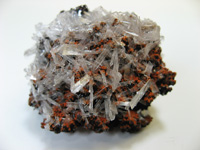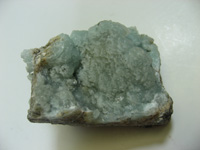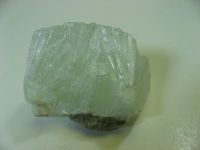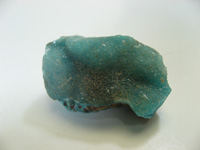![]()
Hemimorphite, is a sorosilicate mineral which has been mined for many centuries from the upper parts of zinc and lead ores, chiefly associated with smithsonite. It was often assumed to be the same mineral and both were classed under the same name of calamine. In the second half of the 18th century it was discovered that there were two different minerals under the heading of calamine - a zinc carbonate and a zinc silicate, which often closely resembled each other. The silicate was the more rare of the two, and was named hemimorphite because of the hemimorph development of its crystals. This unusual form, which is typical of only a few minerals, means that the crystals are terminated by dissimilar faces. The regions on the Belgian-German border are well known for their deposits of hemimorphite of meta somatic origin, especially Vieille Montagne in Belgium and Aachen in Germany. Other deposits are near Tarnovice in upper Silesia, Poland; near Phoenixville, Pennsylvania; the Missouri lead-zinc district; Elkhorn, Montana; Leadville, Colorado; and Organ Mountains, New Mexico in the United States; and in several localities in North Africa. Further hemimorphite occurrences are the Padaeng deposit near Mae Sod in western Thailand; Sardinia; Nerchinsk, Siberia; Cave del Predil, Italy; Bleiberg, Carinthia, Austria; Matlock, Derbyshire, England.
![]()
Within the metaphysical realm of minerals, hemimorphite can further enhance the believer's self-esteem when they maintain the honesty of their relationship to reality. It is an excellent stone to assist the believer in growing toward ego-less self-confidence and self-respect. It brings the believer good luck, a discerning mind and a charming manner. It assists the believer in self-transformation, personal evolution and maintaining or regaining health. It assists the believer in personal growth on all levels, and helps them to evolve and transform in healthy ways. Hemimorphite brings joy and creativity into the believer's life. It brings strong but gentle healing energy as well as assists the believer in accessing ancient healing techniques.
Please note that MIROFOSS does not suggest in any way that minerals should be used in place of proper medical and psychological care. This information is provided here as a reference only.
![]() Hemimorphite is an important ore of zinc and contains up to 54.2% of the metal.
Hemimorphite is an important ore of zinc and contains up to 54.2% of the metal.
![]()
Hemimorphite is a secondary mineral in the weathered portions of zinc deposits.
![]()
Hemimorphite most commonly forms crystalline crusts and layers, also massive, granular, rounded and reniform aggregates, concentrically striated, or finely needle-shaped, fibrous or stalactitic, and rarely fan-shaped clusters of crystals. Some specimens show strong green fluorescence in short wave ultraviolet light (253.7 nm) and weak light pink fluorescence in long wave UV. Hemimorphite most frequently occurs as the product of the oxidation of the upper parts of sphalerite bearing ore bodies, accompanied by other secondary minerals which form the so-called iron cap or gossan.
![]()
| Cleavage | Perfect | |
| Colour(s) | Brown, Colourless, Greenish grey, Yellow brown, White. | |
| Specific Gravity | 3.45 | |
| Diaphaneity | Translucent to Transparent | |
| Fracture | Conchoidal - Fractures developed in brittle materials characterized by smoothly curving surfaces | |
| Mohs Hardness | 5.0 | |
| Luminescence | Fluorescent, Short UV dull white, Long UV dull white | |
| Lustre | Vitreous (glassy) | |
| Streak | White | |
| Habit(s) | Mammillary to Massive to Stalactitic | |
| Radioactivity | Non-radioactive | |
| Magnetism | Non-magnetic | |
| Electrical | Pyroelectric |
![]()
No known health risks have been associated with hemimorphite. However ingestion of hemimorphite, as with other naturally occurring minerals, is not recommended.
![]()
The following image shows the Elemental breakdown of the mineral hemimorphite along with the mineral crystal structure.
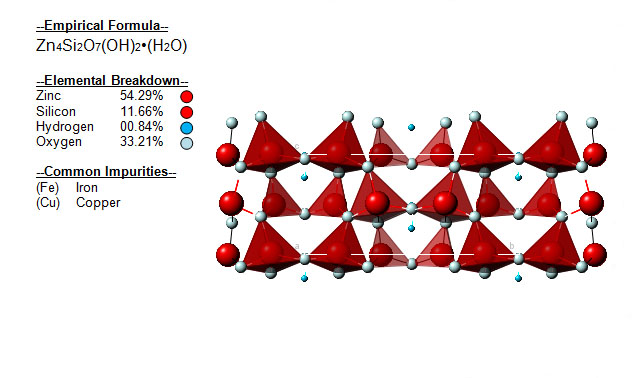
![]()
| Crystal System | Orthorhombic |  |
| Class | Pyramidal | |
| Axial Ratios | a : b : c = 0.7808 : 1 : 0.4776 | |
| Twinning | Thin tabular crystals, sheaf-like or fan-like aggregates | |
| Optical Data Type | Biaxial (+) | |
| Pleochroism (x) | N/A | |
| Pleochroism (y) | N/A | |
| Pleochroism (z) | N/A |  |
| RL Values | nα = 1.614 nβ = 1.617 nγ = 1.636 | |
| 2V | Measured: 46°, Calculated: 44° | |
| Max Birefringence | δ = 0.022 (See colour chart at right) | |
| Surface Relief | Moderate | |
| Dispersion | Strong r > v |
![]()
Hemimorphite can be referenced in certain current and historical texts under the following six names:
The mineral hemimorphite can be translated into the following select languages:
| Arabic | Bulgarian | Chinese (Sim) | 异极矿 | ||
| Croatian | Czech | hemimorfit | Danish | ||
| Dutch | Hemimorfiet | Esperanto | Estonian | ||
| Finnish | French | German | Hemimorphit | ||
| Greek | ημιμορφίτη | Hebrew | המימורפיט | Hungarian | |
| Italian | Emimorfite | Japanese | 異極鉱 | Korean | 햼이몰파잍으 |
| Latin | Lithuanian | Norwegian | |||
| Persian | Polish | Hemimorfit | Portuguese | Hemimorfita | |
| Romanian | Russian | Гемиморфит | Slovak | hemimorfit | |
| Spanish | Hemimorfita | Swedish | Hemimorfit | Tagalog | |
| Turkish | Hemimorfit | Ukrainian | Геміморфіт | Vietnamese |
![]()
Hemimorphite can be found in a few around the world. The map below shows major documented concentrations of hemimorphite:
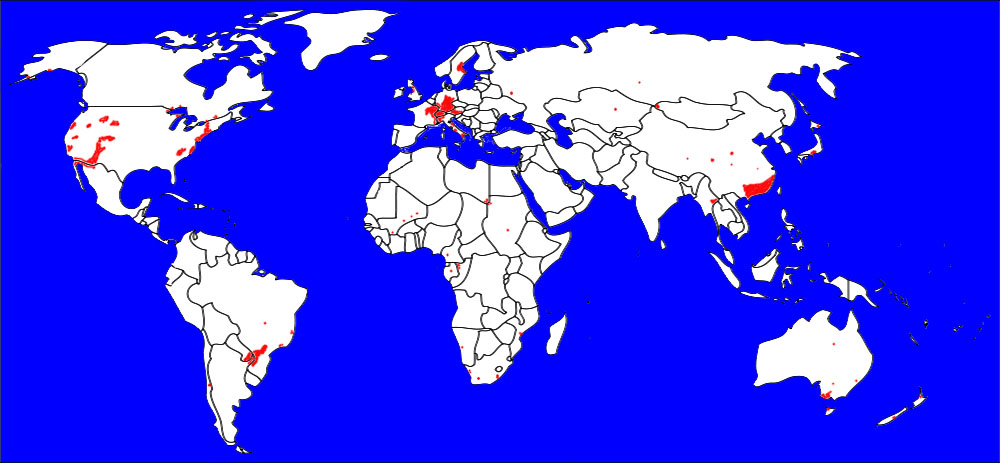
![]()
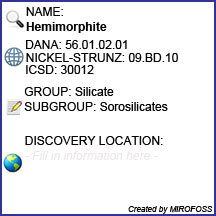 |
The MIROFOSS database offers free printable geological identification tags for personal and non-profit use. These tags can be used to properly identify mineral samples in your collection. -Click here- to download a full size jpeg image for a hemimorphite identification tag; which can be printed on paper or used with a plastic laser printer. |
 |
What's this? What can I do with it? |
![]()
| Chemical Composition | Reynolds, N.A., Chisnall, T.W., Kaewsang, K., Keesaneyabutr, C., and Taksavasu, T., 2003, The Padaeng supergene nonsulfide zinc deposit, Mae Sod, Thailand: Economic Geology, v. 98, p. 773-785. |
| Crystallography | Hurlbut, Cornelius S.; Klein, Cornelis, 1985, Manual of Mineralogy, 20th ed., ISBN 0-471-80580-7 |
| History | Boni, M., Gilg, H.A., Aversa, G., and Balassone, G., 2003, The "Calamine" of southwest Sardinia: Geology, mineralogy, and stable isotope geochemistry of supergene Zn mineralization: Economic Geology, v. 98, p. 731-748 |
| History | European Journal of Mineralogy: 9: 803-810. |
| Geographical Data | Mindat.org. Retrieved on 2013-02-20 |
| Physical Identification | Webmineral.com. Retrieved on 2013-02-20 |
| February 20, 2013 | The last time this page was updated |
| ©2017 MIROFOSS™ Foundation | |
 |
|

